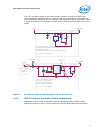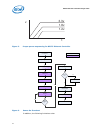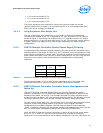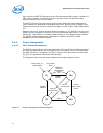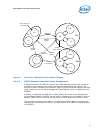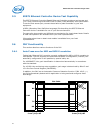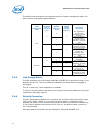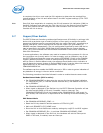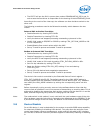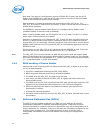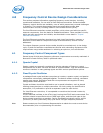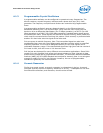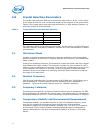
25
82575 Ethernet Controller Design Guide
3.6.7 Auto-Negotiation differences between PHY, SerDes and SGMII
SGMII protocol includes an auto-negotiation process in order to establish the MAC -
PHY connection. This auto-negotiation process is not dependent on the SRDS0/
1_SIG_DET signal, as this signal indicates the status of the PHY signal detection
(usually used in Optical PHY).
The following shows the outcome of this auto-negotiation process:
•Link status
•Speed
•Duplex.
This information is used by the hardware to configure the MAC, when operating in
SGMII mode.
For SerDes and SGMII modes, bits FD and LU of the Device Status register (STATUS),
and bits in the PCS_LSTS register provide status information regarding the negotiated
link.
• Auto-Negotiation may be initiated by the following:
• LRST transition from 1 to 0
• PCS_LCMD.AN_ENABLE transition from 0 to 1
• Receipt of /C/ ordered set during normal operation
• Receipt of different value of the /C/ ordered set during the negotiation process
• Transition from loss of synchronization to synchronized state (if AN_ENABLE is set).
• PCS_LCMD.AN_RESTART transition from 0 to 1
Resolution of the negotiated link determines device operation with respect to speed and
duplex settings. These negotiated capabilities override advertised and software-
controlled device configuration.
When working in SGMII mode, there is no need for setting of the PCAS_ANADV
register, as the MAC advertisement word is fixed. The result of the SGMII level auto-
negotiation can be read from the PCS_LPAB register.
3.6.8 Copper PHY Link Configuration
When operating with the internal PHY, link configuration is generally determined by PHY
Auto-Negotiation. The driver must intervene in cases where a successful link is not
negotiated or the user desires to manually configure the link.
PHY Auto-Negotiation (Speed, Duplex, Flow-Control) when using a copper PHY, the PHY
performs the Auto-Negotiation function. Auto-Negotiation provides a method for two
link partners to exchange information in a systematic manner in order to establish a
link configuration providing the highest common level of functionality supported by
both partners. Once configured, the link partners exchange configuration information to
resolve link settings such as:
• Speed: 10/100/1000 Mb/s
• Duplex: Full- or Half-
• Flow Control Operation
PHY specific information required for establishing the link is also exchanged.
Note: If flow control is enabled, the settings for the desired flow control behavior must be set
by software in the PHY registers and Auto-Negotiation restarted. After Auto-Negotiation



